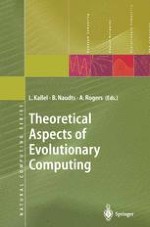2001 | OriginalPaper | Buchkapitel
Cyclic Attractors and Quasispecies Adaptability
verfasst von : J. E. Rowe
Erschienen in: Theoretical Aspects of Evolutionary Computing
Verlag: Springer Berlin Heidelberg
Enthalten in: Professional Book Archive
Aktivieren Sie unsere intelligente Suche, um passende Fachinhalte oder Patente zu finden.
Wählen Sie Textabschnitte aus um mit Künstlicher Intelligenz passenden Patente zu finden. powered by
Markieren Sie Textabschnitte, um KI-gestützt weitere passende Inhalte zu finden. powered by
Using the techniques presented in a previous paper, it is possible to identify cyclic attractors (in the infinite population limit) for the simple genetic algorithm (with zero crossover) when the fitness function is periodic with respect to time. These techniques are applied here to study the adaptability of a quasispecies as the fitness function changes to favour another genotype. The effects of different mutation rates are examined, illustrating the ‘error threshold’ effect, that too high a mutation rate leads to a general collapse of the quasispecies and an inability to track the optimum. Experiments with very low mutation rates illustrate the inability of the population to evolve away from the initial ‘master sequence’ (in which the population clusters around a single genotype) in the face of adverse selective pressure. This result is not reflected in theoretical calculations, indicating that there is a metastable cyclic attractor that dominates for low mutation rates.
